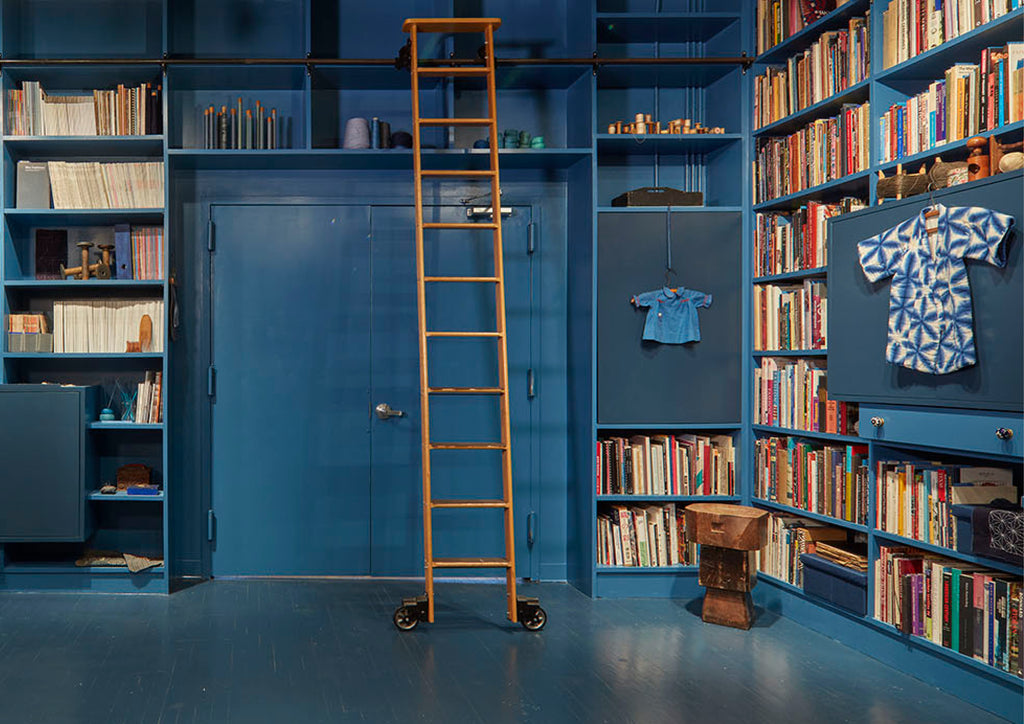 Tatter Blue Library, located in Brooklyn, New York, is home to over six thousand textile-related books and objects.
Tatter Blue Library, located in Brooklyn, New York, is home to over six thousand textile-related books and objects.
Founded by Jordana Munk Martin in 2017, the library and archive demonstrates how textile craft is both a part of our cultural heritage and an essential resource to our wellbeing.
As part of our Time to Make series, Jordana welcomes us on a tour of the space and shows us a personal curated edit from the collection. We find a moment to talk to Jordana about why the library first began, as well as some tips on starting your own archive at home.
What is your artistic background?
I originally trained in painting, receiving a Master of Fine Arts from the Rhode Island School of Design. During my tenure there I hardly picked up a paintbrush, choosing instead to articulate my concepts with fibre. My love of textiles was strong, but it took time to realize they were formally my medium of choice.
Where did your journey with textiles begin?
Textiles have always been a part of my life, I was raised in homes that were filled with them. My grandmother was an avid folk-art collector, she travelled widely and was drawn to storied cloth. Cloth with history, evidence of life, culture and human existence loudly present.
My earliest memories of working with cloth are all from sitting beside my grandmother, learning to knit, embroider and mend. Her charm and loving guidance are fused with those tasks and skills.
 Tell us about the Tatter Blue Library.
Tell us about the Tatter Blue Library.
The forming of Tatter Blue Library came from a combined love of three things: textile craft, community and storytelling.
The library itself is a bit like a living art installation, with fully functioning research capability. It contains over 6,000 books, as well as the full or partial collections of seven different women, so it speaks powerfully to legacy in different forms. Each of our combined collections contain our own unique stories and narratives, and the role that textiles have played in our lives.
The goal of the library is to preserve both ethnographic and technique-based textile knowledge. We see the collection as a springboard for programming, and it is a reminder of how vital and relevant this knowledge is. We currently offer both short and long-form courses in textiles, and the library is used as a platform for authors to share their books. We run a speaker series where textile artists and scholars share their knowledge, and our quarterly journal speaks about all things cloth.
What is it that cloth can teach us?
Within the design and fibres of cloth lies a story. From cloth we can learn about the hands that formed it, as well as the lives that lived within it. We can learn about the function of fabric and the roles it might have played both culturally and ritualistically.
What are a few of your favourite pieces in the archive?
My favourite objects in the library are the ones that remind me of why I built this space in the first place. The portrait of my grandmother, who is always closely present in my mind and heart. Her knitting needles and the case they lay in, which was lovingly made by her best friend Ruth. And a walnut, shell-covered sewing box, which belonged to a woman I never met, but whose objects tell us so much about her. They instantly transport me back in time.
Is there a certain textile treatment or technique you are most drawn to?
I am a knitter through and through. Spun fibre passing across my fingertips is my favourite craft. But recently at Tatter we have begun to offer many hand-sewing classes and I am hooked. Sewing by hand resides in all of us and moving away from the machine connects us to a pre-industrialized time with a renewed appreciation of the craft. There is a real satisfaction to completing a hand-sewn garment - one that you've traversed stitch by stitch.
Somehow, making garments stitch by stitch speaks to our wellbeing and helps us to slow down. Just because you can drive and get there faster, doesn't mean you shouldn't walk and take in the fresh air.
Do you have a couple of tips to share on starting your own archive or library at home?
I always recommend starting with the book The Primary Structure of Fabrics by Irene Emery. It is a bit technical but it is fascinating and a great place to begin.
Then I would head straight for a few books on the textile craft of your choice. For example, On Weaving by Anni Albers, and A Treasury of Knitting Patterns by Barbara Walker. Hand Sewing books are harder to find but there is a great self-published guide by Louisa Owen Sonstroem called Hand Sewing Clothing: A Guide. Louisa is hand-binding each copy herself! And finally, if you can, I recommend storming into your mother's or grandmother's library! That's where the most personal of treasure hunting begins ...
What is the best advice you have been given that you would pass on?
Be present with the making skills of your elders and friends. Learn them and then share them freely! They are our cultural heritage, and their sustenance is our sustenance.
You can watch Jordana's tour of the Tatter Blue Library on our IGTV channel.
Images courtesy of Tatter Blue.
Add a comment